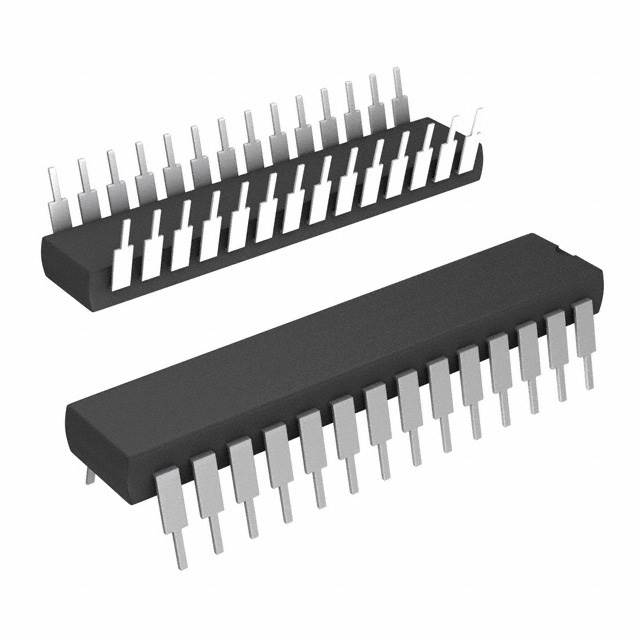Viz Specifikace pro podrobnosti o produktu.

PIC18F2439-E/SP
Product Overview
Category
The PIC18F2439-E/SP belongs to the category of microcontrollers.
Use
This microcontroller is commonly used in various electronic applications that require embedded control and processing capabilities.
Characteristics
- High-performance 8-bit architecture
- Flash memory for program storage
- Integrated peripherals for enhanced functionality
- Low power consumption
- Wide operating voltage range
Package
The PIC18F2439-E/SP is available in a small outline, plastic dual inline package (DIP).
Essence
The essence of this microcontroller lies in its ability to provide efficient and reliable control and processing capabilities in a compact form factor.
Packaging/Quantity
The PIC18F2439-E/SP is typically packaged in reels or tubes, with a quantity of 25 units per package.
Specifications
- Architecture: 8-bit
- Program Memory Size: 16 KB
- RAM Size: 768 bytes
- Number of I/O Pins: 35
- Operating Voltage Range: 2.0V to 5.5V
- Maximum CPU Speed: 40 MHz
- Data EEPROM Size: 256 bytes
- Analog-to-Digital Converter (ADC) Channels: 10
- Timers: 4
- Communication Interfaces: UART, SPI, I2C
Detailed Pin Configuration
The PIC18F2439-E/SP has a total of 35 pins, each serving a specific purpose. The pin configuration is as follows:
- RA0 - Analog Input / Digital I/O
- RA1 - Analog Input / Digital I/O
- RA2 - Analog Input / Digital I/O
- RA3 - Analog Input / Digital I/O
- RA4 - Analog Input / Digital I/O
- RA5 - Analog Input / Digital I/O
- RE0 - Digital I/O
- RE1 - Digital I/O
- RE2 - Digital I/O
- VSS - Ground
- VDD - Power Supply
- RB0 - Digital I/O
- RB1 - Digital I/O
- RB2 - Digital I/O
- RB3 - Digital I/O
- RB4 - Digital I/O
- RB5 - Digital I/O
- RB6 - Digital I/O
- RB7 - Digital I/O
- RB8 - Digital I/O
- RB9 - Digital I/O
- RB10 - Digital I/O
- RB11 - Digital I/O
- RB12 - Digital I/O
- RB13 - Digital I/O
- RB14 - Digital I/O
- RB15 - Digital I/O
- VCAP - Capacitor Connection
- VSS - Ground
- VDD - Power Supply
- OSC1/CLKI - Oscillator Input
- OSC2/CLKO - Oscillator Output
- MCLR/VPP - Master Clear / Programming Voltage
- AN0 - Analog Input
- AN1 - Analog Input
Functional Features
The PIC18F2439-E/SP offers a range of functional features that enhance its capabilities:
- High-speed processing for real-time applications
- Flash memory for program storage and easy reprogramming
- Integrated analog-to-digital converter (ADC) for precise measurements
- Multiple communication interfaces for seamless connectivity
- Timers for accurate timing and event management
- Low power consumption for energy-efficient operation
Advantages and Disadvantages
Advantages
- Compact form factor
- Wide operating voltage range
- Integrated peripherals for enhanced functionality
- Low power consumption
- High-performance architecture
Disadvantages
- Limited program memory size (16 KB)
- Limited RAM size (768 bytes)
- Limited number of I/O pins (35)
Working Principles
The PIC18F2439-E/SP operates based on the principles of microcontroller architecture. It executes instructions stored in its flash memory, interacts with peripherals and external devices through its I/O pins, and performs calculations and data processing tasks.
Detailed Application Field Plans
The PIC18F2439-E/SP finds applications in various fields, including but not limited to:
- Industrial automation
- Consumer electronics
- Automotive systems
- Medical devices
- Home automation
- Internet of Things (IoT) devices
Detailed and Complete Alternative Models
Some alternative models that offer similar functionality to the PIC18F2439-E/SP include:
- PIC18F2431-E/SP
- PIC18F2433-E/SP
- PIC18F2434-E/SP
- PIC18F2438-E/SP
- PIC18F
Seznam 10 běžných otázek a odpovědí souvisejících s aplikací PIC18F2439-E/SP v technických řešeních
What is the maximum operating frequency of PIC18F2439-E/SP?
- The maximum operating frequency of PIC18F2439-E/SP is 40 MHz.What are the key features of PIC18F2439-E/SP?
- Some key features of PIC18F2439-E/SP include 28 KB flash program memory, 256 bytes of EEPROM data memory, and 25 I/O pins.Can PIC18F2439-E/SP be used in battery-powered applications?
- Yes, PIC18F2439-E/SP can be used in battery-powered applications due to its low power consumption features.Is it possible to interface PIC18F2439-E/SP with external sensors?
- Yes, PIC18F2439-E/SP supports various communication interfaces such as SPI, I2C, and UART, allowing it to easily interface with external sensors.What development tools are available for programming PIC18F2439-E/SP?
- Development tools such as MPLAB X IDE and PICkit programmers are commonly used for programming PIC18F2439-E/SP.Can PIC18F2439-E/SP be used in industrial control applications?
- Yes, PIC18F2439-E/SP is suitable for industrial control applications due to its robust design and support for communication protocols.What are the available package options for PIC18F2439-E/SP?
- PIC18F2439-E/SP is available in a 28-pin SPDIP package.Does PIC18F2439-E/SP have built-in analog-to-digital converters (ADC)?
- Yes, PIC18F2439-E/SP features built-in 10-bit ADC modules for analog signal processing.Can PIC18F2439-E/SP be programmed in C language?
- Yes, PIC18F2439-E/SP can be programmed using C language with the help of MPLAB XC compilers.Are there any application notes or reference designs available for PIC18F2439-E/SP?
- Yes, Microchip provides application notes and reference designs to assist in the implementation of PIC18F2439-E/SP in various technical solutions.

